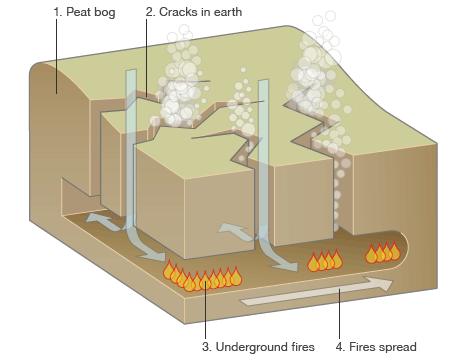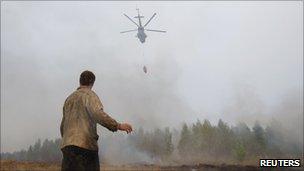Death rate doubles in Moscow as heatwave continues
- Published
Moscow's health chief has confirmed the mortality rate has doubled as a heatwave and wildfire smog continue to grip the Russian capital.
There were twice the usual number of bodies in the city's morgues, Andrei Seltsovsky told reporters.
Meanwhile, a state of emergency has been declared around a nuclear reprocessing plant in the southern Urals because of nearby wildfires.
And there was a new warning over shortfalls in Russia's grain harvest.
Prime Minister Vladimir Putin said this year's harvest, hit by fire and drought, would be worse than previously forecast.
Currently expected to be 65m tonnes, it could be as low as 60m tonnes, Mr Putin said.
Mr Putin also said that a ban on grain exports could be extended beyond the end of 2010 because of shortages for domestic markets.
Russia is the world's third largest wheat exporter. Its biggest customers include Egypt, Turkey and Syria.
As of Monday morning, 557 wildfires continued to burn in Russia, 25 of them peat fires, the emergencies ministry said.
While 239 fires were extinguished on Sunday, 247 new ones were discovered.
The head of the state weather service, Alexander Frolov, said on Monday that the heatwave of 2010 was the worst in 1,000 years of recorded Russian history.
"It's an absolutely unique phenomenon - nothing like it can be seen in the archives," he was quoted by Interfax news agency as saying.
How peat bog fires spread

Peat is formed from decayed vegetation in bogs, moors or swamps.
Deliberate drainage or drought can expose peat to air.
Peat can then be ignited by wildfires or spontaneously combust. The air flow allows the peat to continue burning.
Once alight, the smouldering fire spreads slowly through the peat and can cause the ground above to collapse.
'Puzzling' death data
Recent death rates for parts of central Russia other than Moscow, which are seeing similar droughts and wildfires for more than a month, have not been released.
Soon after Mr Seltsovsky gave his information, Russia's Health Minister, Tatyana Golikova, demanded a formal clarification of his data.
Her ministry said it was "puzzled by the unofficial figures quoted at the briefing".
Mr Seltsovsky did not give a time frame but earlier reports had spoken of the death rate in Moscow for July rising by up to 50% compared with the same period last year.
"On normal days, between 360 and 380 die - now it's around 700," Mr Seltsovsky told reporters.
Moscow, he said, had 1,500 places in its morgues and 1,300 of these were currently occupied.
While stressing there was still capacity, he added that about 30% of bereaved people were asking to have the body kept in a morgue for more than three days, "which slightly complicates the situation".
The concentration of carbon monoxide in Moscow was still more than double acceptable safety norms on Monday as smog from peat and forest wildfires continued to blanket the city.
Temperatures of more than 35C (95F) are forecast for the city until Thursday.
Since the second half of July, at least 52 deaths in Russia as a whole have been attributed directly to fires, which have destroyed hundreds of rural homes.
Mr Seltsovsky did not attribute the rise in the mortality rate to the heatwave or smog but doctors, speaking off the record, have talked of morgues filling with victims of heat stroke and smoke ailments.
Nuclear plant alert
Among the places under threat from the wildfires is a nuclear plant in the Urals. In 1957, it was the site of Russia's worst nuclear disaster.

Fires are still burning across central Russia
Some of the land around the Mayak plant in the town of Ozersk (known in Soviet times as Chelyabinsk-40) is believed to be still contaminated from the disaster, in which a tank of radioactive waste exploded.
Several leaks of radioactive waste have been reported from the plant in recent years.
Ozersk's administration announced on the town's website that residents were forbidden from entering the region's abundant, picturesque woodlands until further notice, and ordered urgent, unspecified fire safety measures.
According to Russia's Itar-Tass news agency, Moscow airports were working normally on Monday after last week's disruptions due to smog.
Sunday saw more than 104,000 air travellers leaving the capital - a record number, according to Russian news agencies.
Those who remain in the city of 10.5m people were being urged to wear face masks if they ventured outdoors, and to hang wet towels indoors to attract dust and cool the airflow.
Most apartments in the city lack air conditioning and there are media reports of wealthier citizens moving out of their homes into hotels, shopping malls, offices and private cars.
- Published9 August 2010
- Published9 August 2010
- Published4 August 2010
- Published6 August 2010